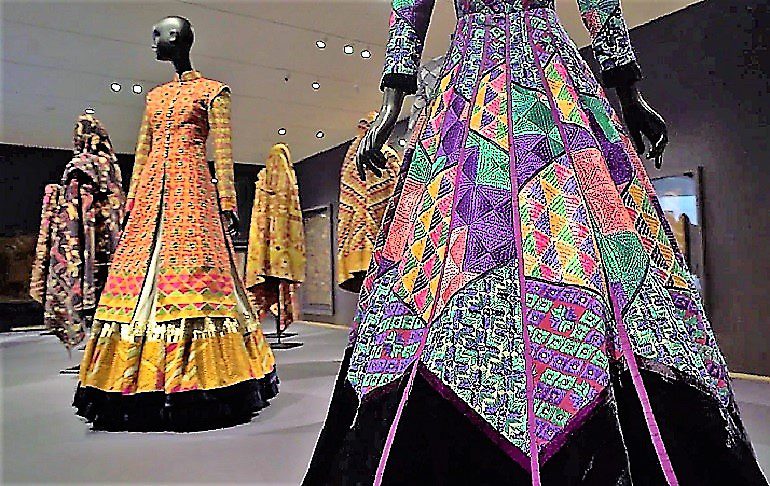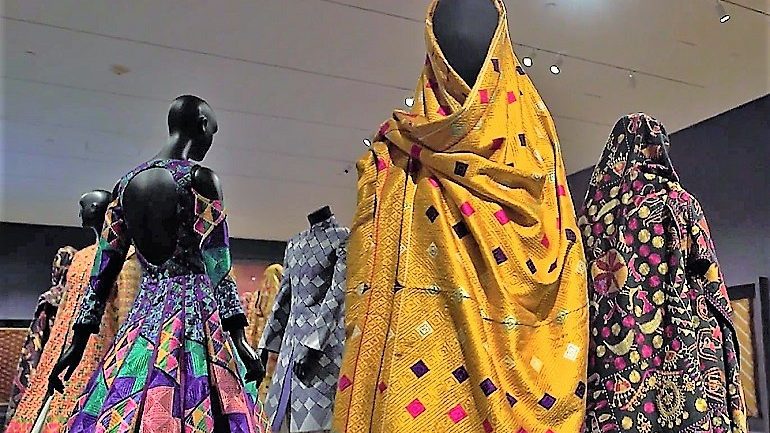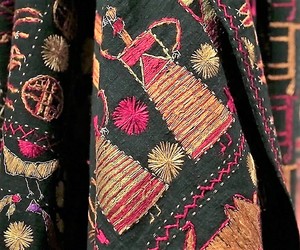ART NEWS
A beautiful yellow and red 8ft x 5ft shawl worn by Punjab women is part of Phulkari: The Embroidered Textiles of Punjab from the Jill and Sheldon Bonovitz Collection at the Philadelphia- Museum of Art.
ART REVIEW
Phulkari Embroidered Textiles of Punjab from the Jill and Sheldon Bonovitz Collection at the Philadelphia Museum of Art reexamines the history of this powerful symbol of Punjabi cultural identity.
BY KAZEEM ADELEKE
PHILADELPHIA— Presently at the Philadelphia Museum of Art is the exhibition Phulkari: The Embroidered Textiles of Punjab from the Jill and Sheldon Bonovitz Collection. The Jill and Sheldon Bonovitz Collection includes some of the best examples of phulkari, many of which have been promised to the Philadelphia Museum of Art. Adding further context to the show are traditional phulkari from the museum’s collection and a high fashion ensemble by Manish Malhotra, one of India’s leading designers.
Phulkari Embroidery Designs Motifs
Phulkari, (Flower work), are ornately embroidered textiles with great beauty and cultural significance. They are mostly found in Punjab, a region straddling Pakistan and India.
The Phulkari Embroidery designs on display present the regal of these embroidered textiles and the pain that went into creating them. Making a phulkari involves a labor-intensive process and takes months, if not years, to create. It is no wonder that it is a powerful symbol of Punjabi cultural identity.
On display are large shawls measuring about 8 ft x 5 ft. The beautiful vibrant silk embroidery on a plain-woven cotton cloth shows the creativity that went into creating the designs. The design is meticulous and the colors are captivating.
ART REVIEW| READ ALSO: Authentic African Fabric Was Made in The Netherlands
Phulkari designers borrow from nature and personal experiences. While some phulkari depict animals and village scenes, others portray complex geometric patterns in bold colors. The colors represent good fortune and social standing. What is hard to ignore is the exceptional creativity of the designers. The manner in which they weave red, hot pink, orange, neon green, and gold threads into intricate designs and astonishing beauty is proof of their dexterity. Better still is the unique quality of each phulkari. Since phulkari are handmade, each one is unique.
Phulkari Techniques and Patterns
Phulkaris serve many purposes in Punjabi society. While some women wear them as large shawls on special occasions, others use them as blankets, furniture covers, and wall hangings. Some phulkaris even serve as documentation for important historical events. One of the textiles in the show features a circus with animals and muscular men. Another shawl has religious themes and mirrors. The common thread, however, is that they are exquisite.
The stitches in the phulkari embroidery are delicate and meticulous. For women of many religious groups—Muslims, Hindus, Christians, and Sikhs—who consider Punjab their holy land, phulkari is sacred. Therefore, they do their best to pass the tradition from the older generation to younger ones through a system that encourages continuity and expression of the phulkari religious relevance. Young girls learn the needlework techniques from older female relatives and friends as part of an effort to perpetuate the tradition. In many cases, these young girls create Phulkari embroidery designs to serve as dowry for marriage. They then take their embroidered designs with them to their new homes after marriage.
Partition of India and Pakistan
After the partition of India and Pakistan in 1947, the phulkari tradition became even more important. It became the connecting thread between the Punjabis of India and Pakistan. For a while, people saw a reason to celebrate the phulkari tradition instead of focusing on the split. However, the celebration of the phulkari tradition was particularly important in Pakistan, where Pakistanis embraced it as their own. Soon, phulkari textiles became an important symbol for the new nation of Pakistan. The excitement surrounding r the celebration of the Phulkari lasted for many years. With time, however, the enthusiasm gradually evaporated and phulkari lost its value.
For many years, reports on the survival of the phulkari tradition were not good. Modernization, industrial growth, and global trade were eroding the relevance of phulkari textiles. While it was still important to the older generation of Punjabi women, the partition did not command as much attention with the younger generation. Nonetheless, instead of allowing the tradition to fade away, people strove to keep it alive. Thankfully, the phulkari tradition is experiencing a rebirth, gaining renewed attention in Punjab and the global space.
Manish Malhotra Designs
In the last fifty years, phulkari techniques and patterns have experienced a revival, especially as commercial art. With tourism booming in Pakistan and India, the phulkari tradition has evolved beyond Pakistan. Adding to the popularity of phulkari textiles is the entertainment industry, including films, music, and videos. Today, the Phulkari tradition features prominently in popular music performances and videos. Furthermore, fashion designers are also taking a lot of interest in Phulkari and are using it for high-end designs. One of them is Manish Malhotra. The famous fashion designer recently created a phulkari-based couture collection that took the world by surprise. His designs are part of this important exhibition.
Manish Malhotra’s designs combine traditional with contemporary. In his new designs, Phulkaris are made into jackets, skirts, and silhouettes in a creative and innovative way that gives credence to this traditional textile. Combined with other materials like chiffon, velvet, and lace, the beautifully colored phulkari exudes elegance. Notably, Malhotra’s hybrid designs using Phulkari transcend everyday aesthetics. The confluence of cultures elegantly positions them for a multicultural society.
The Beauty and Elegance of Phulkari
The beauty and elegance of Phulkari radiate across the exhibition space. But perhaps the best place to experience the glory of Phulkari‘s exceptional aesthetic is in the Joan Spain Gallery. Here, the curators intrinsically bring attention to the Phulkari, as well as accentuate their beauty through a captivating installation. The use of mannequins adds real-life experience to the exhibits in a way that people can visualize what the materials look like on Punjabi women who wear them as shawls and contemporary women who wear them as dresses and jackets. The strategic lighting of the show illuminates the designs and gives viewers a better experience of the exhibits on display. The wall texts were also informative.
Phulkari: The Embroidered Textiles of Punjab from the Jill and Sheldon Bonovitz Collection was curated by Darielle Mason, The Stella Kramrisch Curator of Indian and Himalayan Art, Philadelphia Museum of Art; Dilys E. Blum, The Jack M. and Annette Y. Friedland Senior Curator of Costume and Textiles, Philadelphia Museum of Art; and Dr. Cristin McKnight Sethi, Assistant Professor, The George Washington University, Washington, DC
Phulkari Embroidered Textiles

Phulkari: The Embroidered Textiles of Punjab from the Jill and Sheldon Bonovitz Collection. Through July 9, 2017, at the Philadelphia Museum of Art.
Join the art conversation: Share your thoughts and comments. Facebook– Twitter–Instagram

